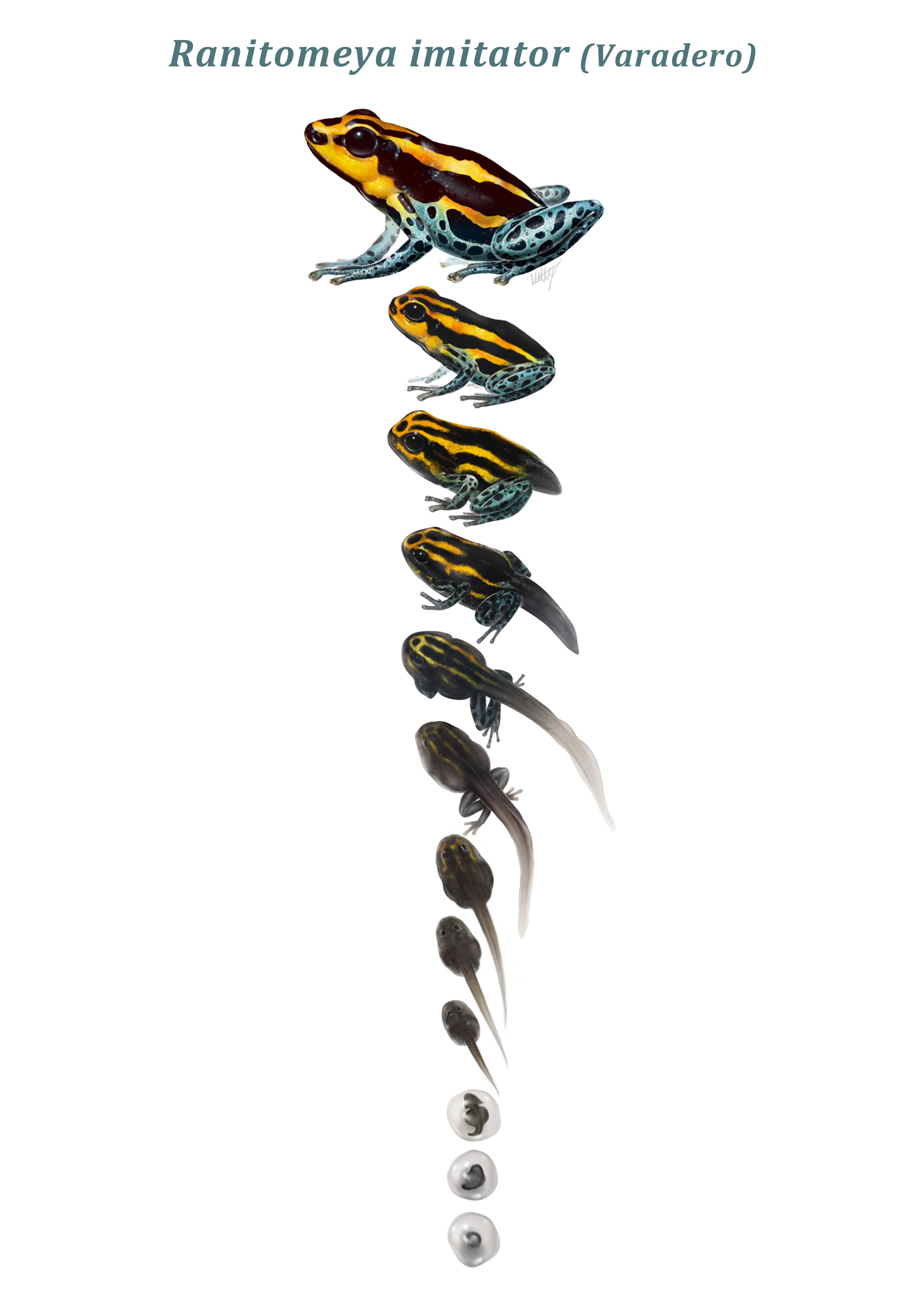Dendrobates Imitator on:
[Wikipedia]
[Google]
[Amazon]
''Ranitomeya imitator'' ( formerly ''Dendrobates imitator''), is a species of
 ''Ranitomeya imitator'' and related frogs exhibit a degree of parental care, with the female laying feeder eggs for the tadpoles to eat. This frog is the first amphibian species in which the sexual partners have been shown to be
''Ranitomeya imitator'' and related frogs exhibit a degree of parental care, with the female laying feeder eggs for the tadpoles to eat. This frog is the first amphibian species in which the sexual partners have been shown to be
poison dart frog
Poison dart frog (also known as dart-poison frog, poison frog or formerly known as poison arrow frog) is the common name of a group of frogs in the family Dendrobatidae which are native to tropical Central and South America. These species are ...
found in the north-central region of eastern Peru
, image_flag = Flag of Peru.svg
, image_coat = Escudo nacional del Perú.svg
, other_symbol = Great Seal of the State
, other_symbol_type = Seal (emblem), National seal
, national_motto = "Fi ...
. Its common names include mimic poison frog and poison arrow frog, and it is one of the best known dart frogs.J.L. Brown, E. Twomey (2011). “ZOOTAXA: A taxonomic revision of the Neotropical poison frog genus Ranitomeya (Amphibia: Dendrobatidae)” Magnolia Press pp. 68-72. In Schulte, Rainer (1989). “Eine Neue Dendrobates- Art aus Ostperu (Amphibia: Salentia: Dendrobatidae) pp. 11-21 It was discovered in the late 1980s by Rainer Schulte who later split it up into more subspecies; describing each as a specific color morph, and sometimes having a separate behavioral pattern. The acoustics, morphs, and behavior of the species have been extensively researched.
Morphology
A few of the morphs include, but are not limited to, striped, spotted, Varadero, and banded.Ranitomeya imitator”. dendrobates.org. In Schulte, Rainer (1989). “Eine Neue Dendrobates- Art aus Ostperu (Amphibia: Salentia: Dendrobatidae) Sauria 8(3): 11-20. The striped morph is the most widely spread, mimicking the striped ''Ranitomeya variabilis
''Ranitomeya'' is a genus of dart poison frogs found in Panama and South America south to Peru and Brazil, possibly into Bolivia.
Taxonomy
In 2006 Grant ''et al.'' revised the systematics of poison dart frogs and placed many species formerly cla ...
'' and can be found throughout the lower Huallaga River
The Huallaga River is a tributary of the Marañón River, part of the Amazon Basin. Old names for this river include ''Guallaga'' and ''Rio de los Motilones''. The Huallaga is born on the slopes of the Andes in central Peru and joins the Marañón ...
drainage in Peru. The spotted morph mimics the highland spotted frog ''Ranitomeya variabilis'' with mainly blue-green coloration, but can be found in other forms, sometimes in yellow. The ''aradero'' morph is a lowland form that lives nearby another but does not resemble it. Last, the banded morph, a mimic of '' Ranitomeya summersi'', lives in much drier climates than the average ''R. imitator'' and is most often found in '' Dieffenbachia'' and ''Heliconia
''Heliconia'', derived from the Greek word (), is a genus of flowering plants in the monotypic family Heliconiaceae. Most of the ca 194 known species are native to the tropical Americas, but a few are indigenous to certain islands of the we ...
'' plants.
Toxicity
Like most other ''Ranitomeya'' species, ''R. imitator'' has a mild toxicity compared to other poison dart frogs. It produces the potent pumiliotoxin B, but its small size limits the amount of poison it can secrete. Like other poison dart frogs, it does not produce toxin in captivity. It probably gains its poison from consuming toxic insects or other invertebrates in the wild. Frogs of the related genus ''Phyllobates
''Phyllobates'' is a genus of poison dart frogs native to Central and South America, from Nicaragua to Colombia. There are 3 different Colombian species of ''Phyllobates'', considered highly toxic species due to the poison they contain in the wil ...
'' may derive their toxins from local melyrid beetles of genus ''Choresine
''Choresine'' is a genus of beetles that belong to the Melyridae family. This genus of beetle is known to have high levels of batrachotoxins and is believed to be a possible toxin source for Pitohui and Blue-capped ifrit birds in New Guinea. Coll ...
''.
Reproduction and parental care
 ''Ranitomeya imitator'' and related frogs exhibit a degree of parental care, with the female laying feeder eggs for the tadpoles to eat. This frog is the first amphibian species in which the sexual partners have been shown to be
''Ranitomeya imitator'' and related frogs exhibit a degree of parental care, with the female laying feeder eggs for the tadpoles to eat. This frog is the first amphibian species in which the sexual partners have been shown to be monogamous
Monogamy ( ) is a form of Dyad (sociology), dyadic Intimate relationship, relationship in which an individual has only one Significant other, partner during their lifetime. Alternately, only one partner at any one time (Monogamy#Serial monogamy, ...
.
Ownership
Compared to many other dart frog species, ''Ranitomeya imitator'' has relatively large and stable wild populations. However, they are often illegally collected and exported. “Clare, John (July 30, 2011). “Imitating Dart Frog, Ranitomeya imitator/Dendrobates imitator (Schulte, 1986) - Care and Breeding”. frogforum.net They have also been imported legally, and multiple captive-bred varieties exist in the pet trade.References
{{Taxonbar, from=Q146330 Endemic fauna of Peru Amphibians of Peru Poison dart frogs Amphibians described in 1986 Ranitomeya